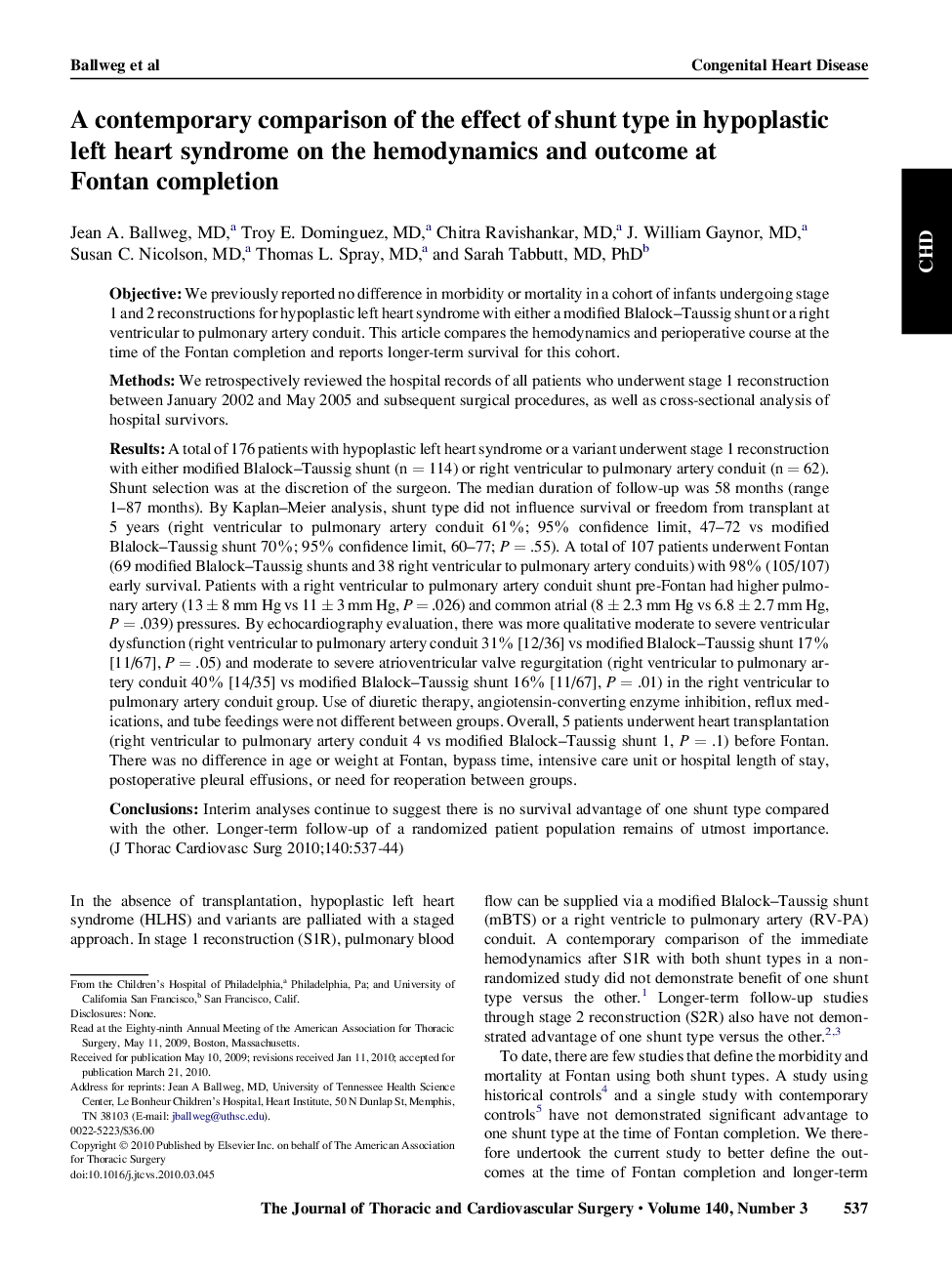| کد مقاله | کد نشریه | سال انتشار | مقاله انگلیسی | نسخه تمام متن |
|---|---|---|---|---|
| 2983350 | 1578658 | 2010 | 8 صفحه PDF | دانلود رایگان |

ObjectiveWe previously reported no difference in morbidity or mortality in a cohort of infants undergoing stage 1 and 2 reconstructions for hypoplastic left heart syndrome with either a modified Blalock–Taussig shunt or a right ventricular to pulmonary artery conduit. This article compares the hemodynamics and perioperative course at the time of the Fontan completion and reports longer-term survival for this cohort.MethodsWe retrospectively reviewed the hospital records of all patients who underwent stage 1 reconstruction between January 2002 and May 2005 and subsequent surgical procedures, as well as cross-sectional analysis of hospital survivors.ResultsA total of 176 patients with hypoplastic left heart syndrome or a variant underwent stage 1 reconstruction with either modified Blalock–Taussig shunt (n = 114) or right ventricular to pulmonary artery conduit (n = 62). Shunt selection was at the discretion of the surgeon. The median duration of follow-up was 58 months (range 1–87 months). By Kaplan–Meier analysis, shunt type did not influence survival or freedom from transplant at 5 years (right ventricular to pulmonary artery conduit 61%; 95% confidence limit, 47–72 vs modified Blalock–Taussig shunt 70%; 95% confidence limit, 60–77; P = .55). A total of 107 patients underwent Fontan (69 modified Blalock–Taussig shunts and 38 right ventricular to pulmonary artery conduits) with 98% (105/107) early survival. Patients with a right ventricular to pulmonary artery conduit shunt pre-Fontan had higher pulmonary artery (13 ± 8 mm Hg vs 11 ± 3 mm Hg, P = .026) and common atrial (8 ± 2.3 mm Hg vs 6.8 ± 2.7 mm Hg, P = .039) pressures. By echocardiography evaluation, there was more qualitative moderate to severe ventricular dysfunction (right ventricular to pulmonary artery conduit 31% [12/36] vs modified Blalock–Taussig shunt 17% [11/67], P = .05) and moderate to severe atrioventricular valve regurgitation (right ventricular to pulmonary artery conduit 40% [14/35] vs modified Blalock–Taussig shunt 16% [11/67], P = .01) in the right ventricular to pulmonary artery conduit group. Use of diuretic therapy, angiotensin-converting enzyme inhibition, reflux medications, and tube feedings were not different between groups. Overall, 5 patients underwent heart transplantation (right ventricular to pulmonary artery conduit 4 vs modified Blalock–Taussig shunt 1, P = .1) before Fontan. There was no difference in age or weight at Fontan, bypass time, intensive care unit or hospital length of stay, postoperative pleural effusions, or need for reoperation between groups.ConclusionsInterim analyses continue to suggest there is no survival advantage of one shunt type compared with the other. Longer-term follow-up of a randomized patient population remains of utmost importance.
Journal: The Journal of Thoracic and Cardiovascular Surgery - Volume 140, Issue 3, September 2010, Pages 537–544